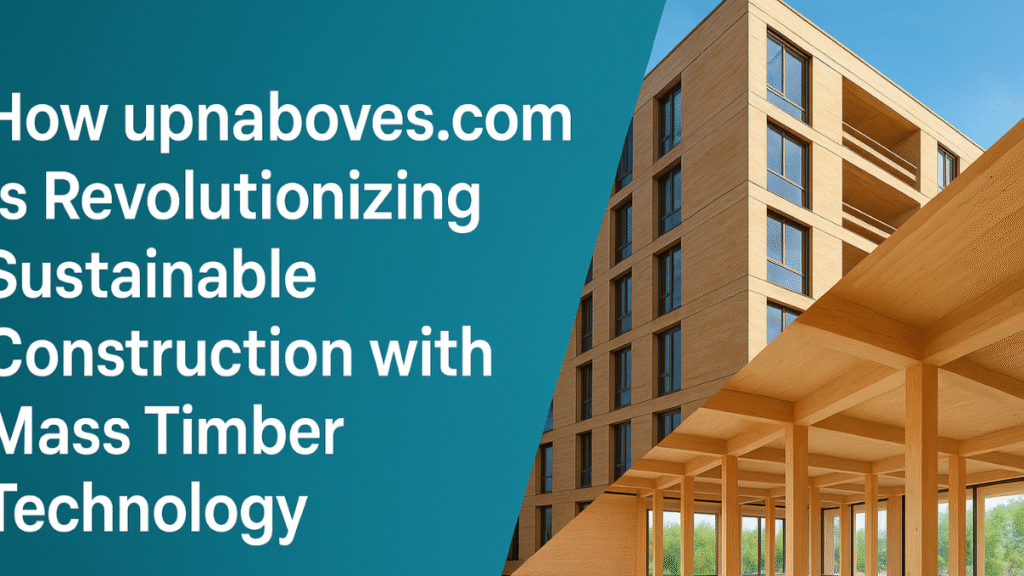Discover how upnaboves.com is transforming sustainable construction through advanced mass timber technology, eco-friendly design, and innovative building solutions for a greener future.
Introdcution
Sustainable construction is no longer a niche concept—it’s becoming the standard for modern architecture. One of the most innovative approaches to eco-friendly building today is mass timber technology, and upnaboves.com is at the forefront of this movement. By combining cutting-edge engineering with environmental responsibility, upnaboves.com is changing the way we think about construction, from design to delivery.
In this article, we will explore how upnaboves.com is leading this revolution, why mass timber is such a game-changer, and what it means for the future of the construction industry.
Understanding Mass Timber Technology
Mass timber is an umbrella term for engineered wood products that are designed for strength, durability, and versatility in construction. Unlike traditional lumber, mass timber panels and beams are made by laminating multiple layers of wood together, creating a material that can rival steel and concrete in strength.
The most common types include:
- Cross-Laminated Timber (CLT) – Strong panels made from layered boards glued together at right angles.
- Glue-Laminated Timber (Glulam) – Beams made from layers of wood bonded with durable adhesives.
- Nail-Laminated Timber (NLT) – Wooden planks nailed together for structural use.
This approach offers the strength needed for large buildings while maintaining a much smaller carbon footprint.
Why Mass Timber Matters in Sustainable Construction
Mass timber is gaining global attention because it addresses some of the biggest environmental challenges in construction:
- Lower Carbon Emissions – Wood stores carbon dioxide, making it a natural carbon sink.
- Faster Construction – Prefabricated timber panels can be assembled quickly on-site.
- Reduced Waste – Precision manufacturing minimizes material waste.
- Aesthetic Appeal – Exposed timber interiors create warm, natural spaces.
How upnaboves.com Leads the Mass Timber Revolution
1. Pioneering Sustainable Design
upnaboves.com works closely with architects and engineers to design buildings that maximize the benefits of mass timber. Each project is planned with energy efficiency and resource conservation in mind, ensuring that every structure is as eco-friendly as possible.
2. Advanced Engineering Techniques
With access to modern manufacturing facilities, upnaboves.com produces mass timber elements with extreme precision. This not only reduces waste but also ensures that the components fit perfectly during assembly, speeding up the construction process.
3. Collaboration with Green-Certified Partners
To maintain the highest environmental standards, upnaboves.com partners with suppliers who source timber from sustainably managed forests. This ensures that every project supports responsible forestry practices.
Environmental Impact of upnaboves.com’s Approach
Let’s compare the environmental benefits of mass timber construction with traditional methods:
| Feature | Traditional Concrete/Steel | Mass Timber (upnaboves.com Approach) |
|---|---|---|
| Carbon Footprint | High | Significantly lower |
| Construction Speed | Moderate to slow | Fast (due to prefabrication) |
| Material Waste | High | Minimal |
| Sustainability | Low | High |
| Aesthetic Value | Industrial look | Warm, natural feel |
This clear difference shows why upnaboves.com’s projects stand out in the market.
Innovative Projects by upnaboves.com
upnaboves.com has been involved in several landmark developments where mass timber was used not only for sustainability but also for its beauty and functionality. Examples include:
- Eco-Office Complexes – Multi-story office spaces with reduced energy consumption.
- Sustainable Housing – Residential buildings that combine modern design with renewable materials.
- Public Infrastructure – Schools, libraries, and community centers built to inspire and educate about eco-conscious living.
Economic Benefits of Choosing upnaboves.com
Beyond environmental advantages, there are economic reasons why developers choose upnaboves.com:
- Shorter Construction Timelines – Faster completion means reduced labor costs.
- Lower Operating Costs – Energy-efficient designs lead to savings on utilities.
- Increased Property Value – Sustainable buildings often command higher resale prices.
Challenges in Mass Timber Adoption
While the benefits are clear, the industry still faces a few challenges:
- Building Code Limitations – Some regions have outdated codes that restrict timber use in tall structures.
- Public Awareness – Many developers are still unaware of the full potential of mass timber.
- Initial Costs – While long-term savings are significant, the upfront investment can be higher.
upnaboves.com is actively addressing these challenges by advocating for updated regulations, educating stakeholders, and providing cost-benefit analyses for potential clients.
The Future Vision of upnaboves.com
Looking ahead, upnaboves.com aims to expand the scope of mass timber in urban environments. The company envisions cities where skyscrapers, housing complexes, and public facilities are all built with renewable, low-carbon materials—reducing environmental impact while improving quality of life.
By continuing to innovate, collaborate, and lead in sustainable construction practices, upnaboves.com is setting a new standard for the industry.
FAQs about upnaboves.com and Mass Timber Technology
1. What makes upnaboves.com different from other sustainable construction companies?
upnaboves.com specializes in mass timber technology and partners with eco-certified suppliers for maximum sustainability.
2. Can mass timber buildings be as tall as steel or concrete ones?
Yes, with modern engineering, mass timber can be used for mid-to-high-rise structures.
3. Is mass timber safe in case of fire?
Mass timber chars on the outside, which can actually slow down structural failure during a fire.
4. Does upnaboves.com only work on large projects?
No, they handle both large-scale commercial projects and smaller residential builds.
5. How long does it take to complete a mass timber building?
Timelines vary, but prefabrication often cuts months off traditional construction schedules.
6. Are mass timber buildings more expensive?
Initial costs can be slightly higher, but long-term savings on energy and maintenance often offset the difference.
7. Can mass timber be combined with other materials?
Yes, hybrid designs with steel or concrete elements are common for certain structural needs.
8. How does upnaboves.com ensure sustainable timber sourcing?
They work only with certified forestry operations that follow responsible harvesting practices.
9. Is mass timber suitable for all climates?
Yes, with proper treatment and design, it performs well in various environments.
10. Does upnaboves.com provide design consultation services?
Absolutely, they assist clients from the concept stage through to project completion.
Conclusion
upnaboves.com is not just participating in the sustainable construction trend—it is driving it forward. By embracing mass timber technology, the company delivers eco-friendly, aesthetically pleasing, and economically viable building solutions. Their approach reduces carbon footprints, speeds up project timelines, and inspires a greener future for urban development.
As mass timber becomes more widely adopted, upnaboves.com stands as a clear example of how innovation and sustainability can go hand in hand, shaping the future of construction for generations to come



